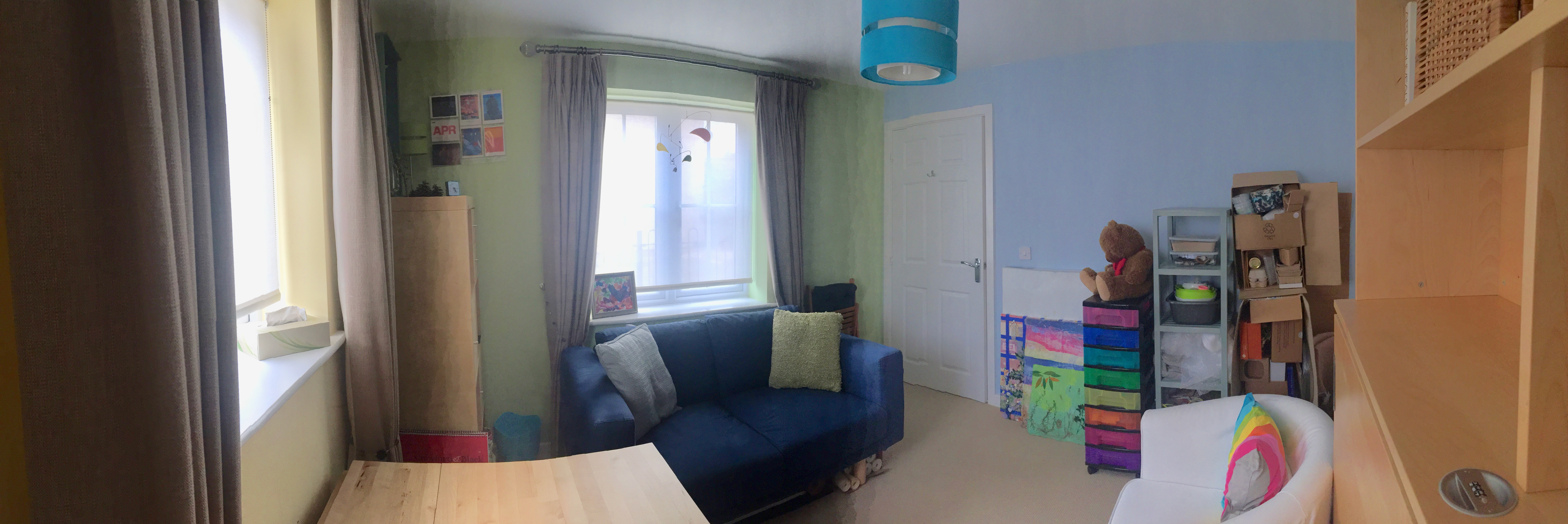I’ve been thinking a lot recently about the importance of space in therapy and counselling.
I am talking, mostly, about the physical room that therapy takes place in. However, this is symbolic and representative of the emotional, relational, reflective space that is formed and ‘held’ for the client each session (and in their minds, in between, as well). It’s come up as an issue from various angles…
I recently had a joint session with another art therapist which took place in her art therapy room. She confessed to being a little nervous about what I would think of it, as I was the first colleague to have visited her there. She was wondering how I would judge her choice of decor, art and play materials, room size, location, and probably many more aspects as well. It was perfectly lovely, and I imagine that most of her clients would have grown to feel contained and comfortable in the space she has created, and go on to make use of the creative space and relationship on offer. Her feelings however, are ones that many can certainly relate to, especially those of us who are self employed and therefore more in control of making decisions about how and where we work, and needing to balance these with what is practical and affordable for us, with providing what is good enough for our clients.
Ending with some long term clients has also reminded me of client’s attachment to the physical room, and items within it, as well as to the relationship with the therapist themselves. It’s been important to work towards these endings gradually, and acknowledge the losses of what has developed into a safe, holding space, in preparation for the next phase in the client’s journeys. Some of that has involved acknowledging that over the course of our work, at some level, the client has formed an ownership over and relationship with various parts or all of the space: indeed, for that hour per week, it is their therapy room as much—or perhaps more so—than mine. At a very deep level, this matters, and I have noticed that clients need to pay tribute to the room, what it contains, and say their goodbyes.

Having a calm and containing space is important to therapeutic work: it helps people relax and feel safe.
In contrast, there are frequent discussions on counsellor and therapy forums, comparing notes about what constitutes adequate space and offering online counselling or therapy. We now function in an online world (and market place) where obtaining things online is perceived as efficient, cost and time-saving, and often… better? An online therapist could conceivably make huge savings on their overheads, and have greater personal flexibility (do they need to pay for a therapy room at all?; could they be working from abroad?). There are potential benefits for busy clients too: saving time and petrol in travelling to see the therapist, for example. I have certainly made use of my supervisor’s offer of the occasional online session when I have been tight for travel time within my schedule, and offered this to my own supervisees when they would otherwise be stuck in heavy traffic and likely miss the session altogether. There is no doubt that supportive and meaningful therapeutic relationships can be formed and maintained in a virtual ‘space’, but I do also wonder, if this is the sole way of operating, how many aspects of therapy become lost, or rather perhaps not given an opportunity to develop in the first place. There is nothing like seeing a significant other in person, rather than on a screen. Multiple senses kick in and help shape attachments and bonds. Imagine forming a relationship with your new baby, not up close and personal, but online! If this was a default method, life and human relationships would be disconnected and certainly extremely different!

Can online therapy really be a feasible way forward?
Within the practice of art therapy the artworks and materials are a physical objects which need a physical location to exist, be explored and stored. Many of my supervisees who work in schools and other community locations have ongoing challenges in negotiating consistent and adequate therapy rooms, and this is a familiar experience for me too, when I do work in such settings. Competition for space means that rooms are often shared (or changed with little notice) which limits the client’s opportunity to form an attachment to the therapy room. Safe storage space for materials and artwork cannot always be guaranteed, which has an impact on how able the client feels to trust the therapist as provider of resources and guardian of their work. The therapist is often asked to vacate the room as soon as the session is done, leaving them with no quiet or confidential space in which to process the session, or complete essential admin tasks. Without a confidential space to make phone calls or write reports, the therapist faces the dilemma of how to achieve these, and at times, with no available safe locations in which to do so, these elements of best practice get postponed or even sacrificed. We are increasingly in a world where physical space is at a premium, but I don’t think that applying a culture of hot-desking to therapy is a feasible solution: not if it is to retain its core essence and effiacy.
All of these observations resulted in me particularly enjoying one of my already favourite tasks of the year: stock checking, sorting out and deep cleaning my therapy room!

Stock check chaos!
It helps me appreciate more than ever, the calm and safe environment that I have shaped, for myself and others. For me personally, having a reliable space to think, talk, make art, and write is fundamental to good practice and worth investing in. And clients seem to agree…

Leave a Comment